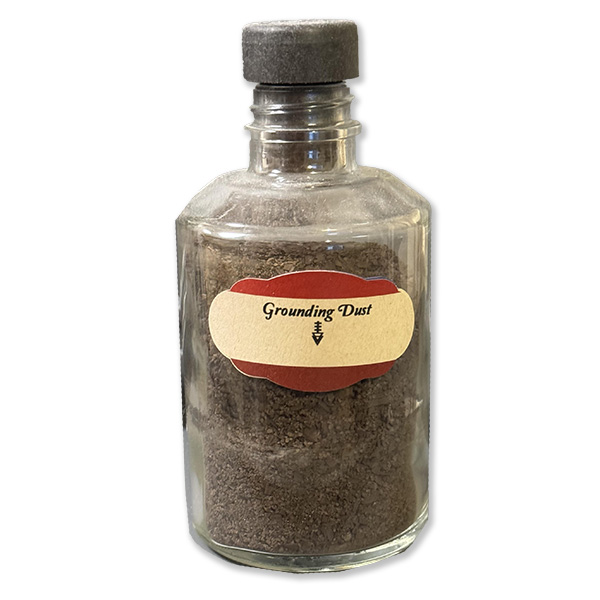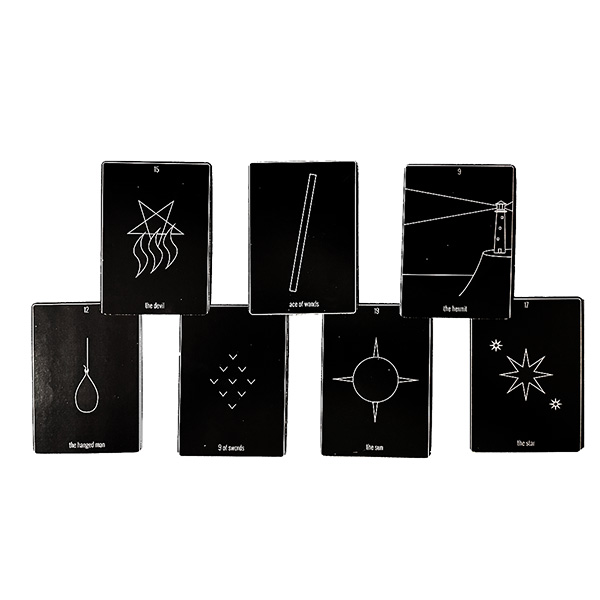Witchy — It's a kind of Magic...
Grounding Dust

A powdered mixture of iron, silver, and salt.
Witchcraft Uses:
Used to create protection circles, protect doorways and windows, "ground" any spells, or simply ruin the day of any fae, were, or spirit.
Minimalist Tarot Deck

A few years back I got curious about the tarot. I figured it has a lot of history and is just fun. I went to look for a good deck to learn with and I wasn't wild about any of the common ones. The tradional Rider-Waite has always seemed a bit cartoony for my tastes and most of the other ones were either very feminine or just didn't speak to me.
"Someone should make a minimalist tarot deck," I said to myself.
You can guess what happened next...
Black Salt
Black Salt, in witchcraft contexts, is a blend of sea salt, charcoal, and sometimes other ingredients that provide its dark color. It's not to be confused with culinary black salt used in some Asian cuisines.
Witchcraft Uses:
Black Salt is primarily used for protection, banishing, and breaking negative spells. It's often sprinkled around properties or carried in pouches as a protective agent against negative energies and as a tool to cleanse
spaces.
Blackthorn Thorn
(Prunus spinosa)
The sharp thorns of the blackthorn bush, these are collected with care due to their potency in physical and energetic protection.
Witchcraft Uses:
Used in witchcraft for casting circles of protection and in the creation of witch bottles and protective charms. They are symbols of sharp defense and resilience.
Graveyard Dirt
Soil collected from a graveyard, used in various magical practices. Its use and collection often come with specific ethical considerations and respect for the deceased.
Witchcraft Uses:
Graveyard Dirt is used in spells involving spirits, protection, and curses. It's believed to ground and bind spells to the earthly realm and can represent the element of Earth in rituals requiring a connection to ancestral
power or the cycle of life and death.
Lodestone Dust
Lodestone is a naturally magnetized piece of the mineral magnetite. Ground into dust, it retains its magnetic properties.
Why It's Cool: Historically used for navigation, as it was the first known type of magnetic compass, lodestone embodies the ancient intersection of science and exploration, guiding humanity's journeys across the seas.
Obsidian Knife
An obsidian knife features a blade made from obsidian, a naturally occurring volcanic glass known for its sharpness. Historically, these knives were used by various cultures for ceremonial purposes, as well as for hunting and cutting.
Why It's Cool:
The obsidian knife is not just a tool but a symbol of precision, clarity, and protection. Its ability to create incredibly sharp edges, sharper than steel surgical blades, showcases the sophistication of ancient technologies.
Moreover, in metaphysical practices, obsidian is valued for its protective qualities and ability to cut through negative energy, making the obsidian knife a powerful symbol in ritual and ceremonial contexts.
Black Scrying Mirror
A black scrying mirror is a tool used in divination, typically made from polished obsidian or glass painted black on one side. It serves as a focal point for personal reflection and to facilitate psychic visions or scrying sessions.
Why It's Cool:
The black scrying mirror embodies the mystery and depth of the unconscious mind. It's cool because it's a gateway to the inner self and the mystical realms beyond our ordinary perception. This ancient practice invites users to
explore the unknown, offering insights, foresights, and a connection to the subconscious, making it a fascinating blend of psychology and the mystical arts.
Volcanic Ash
Fine rocks, minerals, and volcanic glass created during volcanic eruptions. It's used in construction materials, abrasive agents, and as a soil enhancer.
Why It's Cool: Volcanic ash's role in enriching soils and thus supporting agriculture around volcanic areas highlights nature's ability to turn destructive events into sources of life and renewal.
Selenite Knife
A selenite knife is crafted from selenite, a crystalline mineral form of gypsum that is known for its pearlescent, moon-like glow. While not sharp or durable in a traditional sense, it is used in energy work and ceremonial practices.
Why It's Cool:
The selenite knife, with its ethereal appearance and connection to lunar energy, is revered for its ability to clear and charge other crystals, as well as to cut through spiritual or energetic blocks. It represents clarity,
purity, and the flow of energy, serving as a powerful tool in metaphysical practices for cleansing auras and spaces, making it a beautiful and symbolic object of transformation and healing.
Sea Monster Teeth
A symbolic representation, not an actual herb, but often used in spellwork as a representation of ancient wisdom and protection from the deep.
Witchcraft Uses:
"Sea Monster Teeth" can be used as a protective charm or in spells seeking to tap into ancient, primal powers. They symbolize strength, protection, and the untamed forces of nature, offering guardianship and deep, intuitive
knowledge.
Cat's Whiskers
Not a commonly recognized herb in traditional witchcraft, but if referring to the plant (Orthosiphon aristatus), it's used for health and cleansing.
Coffin Nails
Used in spells for protection, cursing, and grounding energies. They symbolize endings and are used to add potency to protective charms or to "nail down" protection.
Dragon Teeth
Mythically, they're used to symbolize protection, power, and the summoning of warriors or guardians in spell work.
Lightning Sand
Also known as fulgurite, formed when lightning strikes sand. It's used for transformation, energy, and communication with higher realms.
Sea Monster Teeth
Symbolically used for protection, deep wisdom, and connecting with ancient or primal energies.
Each of these items brings its own unique vibration and symbolism to magical practices, often rooted in folklore, historical uses, or the energetic properties ascribed to them by modern practitioners. Their inclusion in spells and rituals depends on the desired outcome and the personal associations of the practitioner.